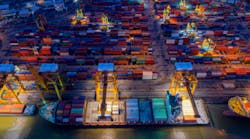Media reports across the country have recently created consumer hysteria over the growing crisis involving cargo-ship backlogs at West Coast seaports, where the ports of Los Angeles and Long Beach alone handle an estimated 40% of all inbound container cargo entering the U.S. While there is clearly cause for concern as it relates to consumers being unable to obtain everything from common household items, imported food products, and more which people need – especially as we head into the upcoming holiday season – the fact remains such situations do not have to be so severe.
True enough, West Coast seaports and airports (especially those throughout the state of California) handle the lion’s share of cargo (specifically electronic appliances, devices, and apparel) entering the U.S. However, just as most people would look for another alternative route(s) in the form of streets, a highway or byway to get to a destination of their choice, food companies awaiting imported products and/or ingredients, and manufacturing companies based overseas should have been knocking on the doors of seaports and airports long before now up and down the Eastern seaboard. Seaports throughout the Southern states of Georgia, Florida, the Carolinas, Virginia, as well as Louisiana are quite capable of handling immense container traffic due to recent infrastructure improvements, deeper dredging, as well as the addition of Panamax and Post-Panamax gantry cranes. And, like California’s seaports, those in the Southeast U.S. are fully operational year-around due to ideal weather conditions.
What most people outside of the maritime industry are unaware of is that it has often been influential shipping companies, bureaucracy, and questionable labor agreements made by weak-spirited union leaders who have continued to pick away at reducing the number of dockworkers (longshoremen and truckers) at job sites that has played the biggest role in causing unnecessary delays and congestion at U.S. seaports. Here lies the problem. While technology and the previously mentioned factors have contributed to a decrease in the number of qualified manual workers on the docks, lower numbers of dockworkers assigned to each ‘work gang’ (crew) necessary to load and unload ships - in one of the most dangerous work environments - continue to create supply chain disruptions.
That means a reduction in the number of hands that physically lash cargo containers, touch twist locks, operate mule trucks, top loaders, and forklifts which are crucial to the overall operation of any seaport. And, having an influx of responsible truck drivers (or access to a railway system) who can transport cargo containers out of seaports and/or deliver to a seaport are just as important to the logistical chain. Yes, fewer numbers of employees on a payroll may help companies generate greater profits for their owners, investors, and senior executives, but it will definitely come with costly, avoidable consequences. Ones which certainly will be felt by disgruntled consumers of products and corporate customers across the nation and around the world.
Another frequently dismissed concept is the consideration of prodding legislators and state-federal prison officials to implement CDL education programs in their penal institutions for inmates who are expected to be released within the next year or two. Equipping soon-to-be released inmates with the ability to acquire proper training and allowing them to test for and earn a commercial driver’s license necessary to operate a tractor-trailer truck not only is a unique incentive aimed at encouraging greater numbers of ex-offenders to become normal tax-paying citizens who can remain gainfully and meaningfully employed upon release, but it simultaneously addresses the recidivism problem in America while solving the lack of available certified truck drivers who could hit the streets and be ready to go to work in a matter of days or weeks. These same drivers could be used by trucking companies, manufacturing companies, local unions of teamsters, and retail outlets to transport containers from seaports and airports locally, regionally and/or across the country.
Oddly enough, like most things today, the issue with addressing and solving problems in America does not fall on a lack of sufficient options or ideas. Instead, the issue often is a result of the lack of common sense, because there are people who would prefer to reap financial rewards for themselves from the continuation of creating or fanning problems instead of implementing solutions that will improve life for the masses.


